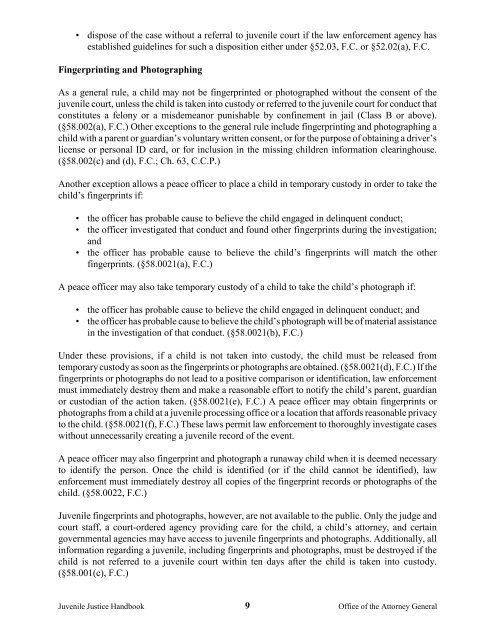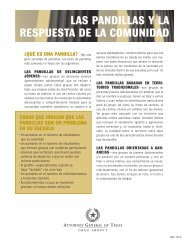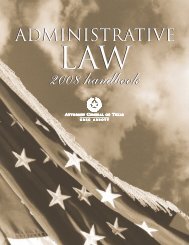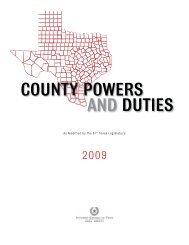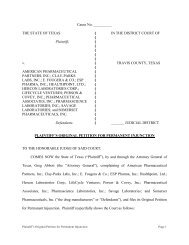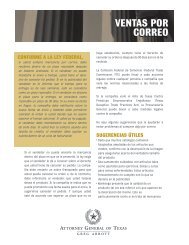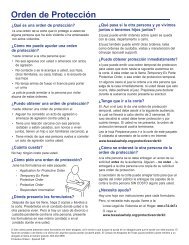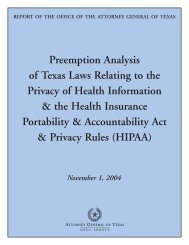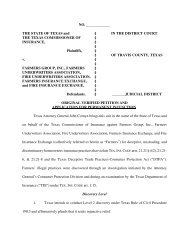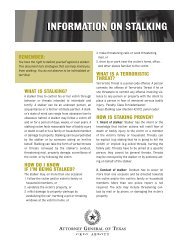Juvenile Justice Handbook - Texas Attorney General
Juvenile Justice Handbook - Texas Attorney General
Juvenile Justice Handbook - Texas Attorney General
You also want an ePaper? Increase the reach of your titles
YUMPU automatically turns print PDFs into web optimized ePapers that Google loves.
• dispose of the case without a referral to juvenile court if the law enforcement agency has<br />
established guidelines for such a disposition either under §52.03, F.C. or §52.02(a), F.C.<br />
Fingerprinting and Photographing<br />
As a general rule, a child may not be fingerprinted or photographed without the consent of the<br />
juvenile court, unless the child is taken into custody or referred to the juvenile court for conduct that<br />
constitutes a felony or a misdemeanor punishable by confinement in jail (Class B or above).<br />
(§58.002(a), F.C.) Other exceptions to the general rule include fingerprinting and photographing a<br />
child with a parent or guardian’s voluntary written consent, or for the purpose of obtaining a driver’s<br />
license or personal ID card, or for inclusion in the missing children information clearinghouse.<br />
(§58.002(c) and (d), F.C.; Ch. 63, C.C.P.)<br />
Another exception allows a peace officer to place a child in temporary custody in order to take the<br />
child’s fingerprints if:<br />
• the officer has probable cause to believe the child engaged in delinquent conduct;<br />
• the officer investigated that conduct and found other fingerprints during the investigation;<br />
and<br />
• the officer has probable cause to believe the child’s fingerprints will match the other<br />
fingerprints. (§58.0021(a), F.C.)<br />
A peace officer may also take temporary custody of a child to take the child’s photograph if:<br />
• the officer has probable cause to believe the child engaged in delinquent conduct; and<br />
• the officer has probable cause to believe the child’s photograph will be of material assistance<br />
in the investigation of that conduct. (§58.0021(b), F.C.)<br />
Under these provisions, if a child is not taken into custody, the child must be released from<br />
temporary custody as soon as the fingerprints or photographs are obtained. (§58.0021(d), F.C.) If the<br />
fingerprints or photographs do not lead to a positive comparison or identification, law enforcement<br />
must immediately destroy them and make a reasonable effort to notify the child’s parent, guardian<br />
or custodian of the action taken. (§58.0021(e), F.C.) A peace officer may obtain fingerprints or<br />
photographs from a child at a juvenile processing office or a location that affords reasonable privacy<br />
to the child. (§58.0021(f), F.C.) These laws permit law enforcement to thoroughly investigate cases<br />
without unnecessarily creating a juvenile record of the event.<br />
A peace officer may also fingerprint and photograph a runaway child when it is deemed necessary<br />
to identify the person. Once the child is identified (or if the child cannot be identified), law<br />
enforcement must immediately destroy all copies of the fingerprint records or photographs of the<br />
child. (§58.0022, F.C.)<br />
<strong>Juvenile</strong> fingerprints and photographs, however, are not available to the public. Only the judge and<br />
court staff, a court-ordered agency providing care for the child, a child’s attorney, and certain<br />
governmental agencies may have access to juvenile fingerprints and photographs. Additionally, all<br />
information regarding a juvenile, including fingerprints and photographs, must be destroyed if the<br />
child is not referred to a juvenile court within ten days after the child is taken into custody.<br />
(§58.001(c), F.C.)<br />
<strong>Juvenile</strong> <strong>Justice</strong> <strong>Handbook</strong> 9<br />
Office of the <strong>Attorney</strong> <strong>General</strong>


